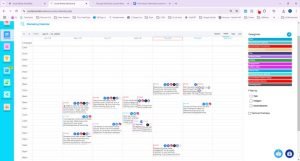Evolution of Blog Posts in Marketing Calendars
How Blog Posts Strengthen Your Marketing Calendar Strategy
Blog posts are no longer just an optional add-on—they’re a cornerstone of a well-structured marketing calendar. For small business owners and marketers alike, blogging has evolved into a strategic content tool that drives search engine visibility, builds trust with your audience, and supports long-term growth.
Today’s blog content isn’t limited to long-form articles. When planned thoughtfully within your marketing calendar, blog posts can align perfectly with seasonal promotions, social media campaigns, product launches, and SEO goals. They offer a platform to demonstrate your expertise, share helpful resources, and engage readers across different stages of the customer journey.
From embedding video and graphics to optimizing for mobile and accessibility, modern blog posts are built to capture attention and deliver value. By strategically timing and promoting each post, you ensure your content reaches the right audience at the right time—driving traffic, boosting engagement, and reinforcing your brand authority.
If you’re looking to build stronger connections, improve organic reach, and stay consistent across channels, integrating blog posts into your marketing calendar isn’t just smart—it’s essential.
Key Takeaways of Blog Posts in Marketing Calendars in Social Media
- Blog posts have evolved from simple content pieces to strategic elements in marketing calendars for ongoing audience engagement.
- They now incorporate SEO strategies, including the use of long tail keywords to improve visibility and relevancy.
- Integration of multimedia, interactive polls, and social sharing features in blog posts enhances user interaction and engagement.
- Continuous content updates and the use of analytics have become crucial for maintaining the effectiveness of blog posts in marketing strategies.
- Modern blog posts focus on niche targeting and collaboration with influencers to expand reach and personalize content.
The Origins of Blogging in Marketing Strategies
The adoption of blogging in social media marketing strategies revolutionized how companies engage with their audience. Initially, blogging’s origins were humble—personal online journals for individuals to share their thoughts. However, marketers quickly noticed its potential. As marketing evolution unfolded, blogs became a strategic tool. They allowed businesses to offer valuable content, establish thought leadership, and improve search engine visibility.
You’ve seen how this shift isn’t just about promoting products; it’s about creating conversations and building relationships. Companies that embraced blogging early on differentiated themselves, providing insights and solutions that resonated with their target audiences.
This approach not only enhanced their digital presence but also set new standards in customer engagement and content marketing.
 The Shift From Traditional to Digital Content
The Shift From Traditional to Digital Content
As marketing strategies evolved, a significant transformation occurred with the advent of digital content, moving away from traditional media forms like print and broadcast. You’ve seen this shift firsthand. The digital transformation has reshaped how you interact with brands, pushing marketing into a domain where engagement is instantaneous and measurable.
Traditional media once ruled with its one-way communication, but now, digital platforms allow you to talk back, share your thoughts, and even influence brand strategies. This change isn’t just about swapping out the tools—it’s about rethinking how to connect with audiences like you.
As you scroll through your feeds and websites, remember, each click and share shapes the future of marketing, steering it further away from the old norms of traditional media.
Key Milestones in Blog Integration
You’ve seen how blogs started gaining traction; now let’s look at how they became integral to marketing strategies. Initially, businesses recognized the potential of blogs during the early adoption stages, setting the stage for what was to come. As content strategy was refined, the impact on digital marketing became undeniable, reshaping promotional landscapes dramatically.
Early Adoption Stages
While businesses were still grappling with the digital revolution, early adopters began integrating blogs as pivotal tools in their marketing arsenals. You’ve probably noticed how swiftly some companies were ahead of the curve. These pioneers recognized the potential of blogs to create a lasting impact.
By harnessing blogging benefits, they not only boosted their SEO but also established a deeper connection with their audience. Early adoption meant they could dominate niche topics and position themselves as thought leaders, setting the stage for sustained engagement and trust. You should consider how these early stages of adopting blogs might influence your strategies.
Think about using blogs not just for outreach but as a cornerstone for building your brand’s voice and authority.
Content Strategy Refinement
After the initial adoption phase, refining your content strategy becomes essential to maintaining relevance and enhancing engagement. You’ll need to focus on aligning your blog content with both your brand’s goals and your audience’s evolving interests. This isn’t just about tweaking what you’ve done; it’s about strategically enhancing every post to hit the right notes.
Start by diving deep into audience segmentation. Understanding the varied preferences and behaviors of your audience segments guides you to create more targeted and impactful content. As you align your posts more closely with these insights, you’ll see a significant uptick in engagement. Each piece of content should resonate well with a specific segment, ensuring your blog’s role in your broader marketing strategy is both clear and effective.
Digital Marketing Impact
As blog posts became integral to digital marketing strategies, several key milestones marked their evolution. You’ve seen firsthand how these changes have shaped the way you interact with content online. Initially, blogs were mere digital diaries, but they quickly became pivotal in driving digital engagement.
The introduction of SEO optimized content allowed you to find exactly what you were looking for, transforming how audience behavior was understood and catered to. Analytics tools then gave you insights into which posts resonated most, enabling marketers to tailor content more effectively.
Recently, the rise of AI-driven content generation has begun to further refine how blogs are integrated into broader marketing strategies, ensuring they’re not just seen but are also impactful and relevant.
 Technological Advancements Impacting Blog Posts in Marketing Calendars
Technological Advancements Impacting Blog Posts in Marketing Calendars
Technological advancements have markedly transformed how blogs are utilized in marketing. AI tools and content automation streamline the creation process, making it faster and tailored to your specific audience’s preferences. Analytics software digs deep into engagement metrics, providing insights that weren’t previously accessible. You’re now equipped to enhance user experience considerably.
| Feature | Benefit | Examples |
|---|---|---|
| Mobile Optimization | Access on the go | Responsive design |
| Social Sharing | Wider reach | Share buttons |
| Visual Storytelling | Engaging content | Infographics |
Blogging platforms have evolved; they support a range of multimedia, boosting your blog’s appeal. Content personalization isn’t just a buzzword—it’s your strategy to captivate. With these tools, you’re not just posting content, you’re crafting experiences.
Our Through Fresh Eyes Social Media Management Platform simplifies sharing your blog posts by offering an innovative feature for evergreen content reposting. With just a few clicks, you can set your timeless blog posts to automatically reshare on your social channels at intervals you specify. This ensures your valuable content continues to reach new audiences and drive engagement without requiring you to manually repost. Maximize your content’s lifespan and keep your feed active effortlessly with our user-friendly tools, designed to make social media management a breeze.
Try Your Two Week Free Trial Here
Analyzing the Role of SEO in Blog Development
As you explore the role of SEO in blog development, it’s essential to understand how keyword integration techniques can elevate your content’s visibility. The strategic placement of keywords not only enhances search rankings but also aligns with user search intent, making your posts more discoverable.
Keyword Integration Techniques
When integrating keywords into your blog posts, it’s essential to balance SEO benefits with the natural flow of your content. You want to engage readers, not just bots. Strategic keyword placement is your ally. By weaving long tail keywords into your introduction, headers, and conclusion, you guarantee a smoother reading experience while boosting your SEO potential. These keywords often have lower competition and are more specific, aligning closely with user intent.
| Emotion | Keyword Strategy |
|---|---|
| Reassurance | Natural Keyword Flow |
| Confidence | Strategic Placement |
| Satisfaction | Use of Long Tail Keywords |
Impact on Search Rankings
Understanding how SEO influences your blog’s search rankings is essential, as it directly impacts visibility and engagement. Integrating key search ranking factors can substantially boost your blog’s position on search engine results pages, driving more organic traffic to your site. You’ve got to focus on quality content enriched with relevant keywords, optimized meta tags, and engaging, shareable posts.
These elements signal search engines that your content is valuable, which can improve your rankings. Additionally, regular updates with fresh content keep your site dynamic and more appealing to search algorithms.
 Blog Content: From Text to Multimedia on Social Media
Blog Content: From Text to Multimedia on Social Media
Why have modern blog posts evolved from plain text to vibrant multimedia formats? You’ve noticed it yourself; the shift isn’t just about visuals—it’s about engaging you more deeply. Multimedia storytelling isn’t just an embellishment. It’s a strategic approach to catch your eye and keep you scrolling.
Videos, podcasts, infographics, and interactive content aren’t just add-ons; they’re integral elements that enhance your understanding and enjoyment. This evolution is driven by your desire for more dynamic and immersive experiences. As your attention span competes with countless online distractions, content creators use diverse media to provide richer, more engaging posts.
Audience interaction has become key. Features like embedded polls and clickable slideshows invite you to participate, not just passively consume.
Future Trends in Blog Posts in Marketing Calendars
As marketing strategies evolve, so too must the content of blog posts in your marketing calendars. You’ll need to embrace user-generated content and audience personalization to stay ahead. This approach makes your readers feel directly involved and catered to.
Interactive blogging isn’t just a buzzword; it’s a way to engage dynamically with your audience through quizzes, polls, and real-time updates. Focus on mobile optimization and visual storytelling to capture the increasingly mobile audience. Your blogs should load quickly and look great on smaller screens.
Also, integrate social media seamlessly to amplify reach and engagement. Niche targeting and influencer collaborations can drive highly focused traffic and enhance credibility. Keep these trends in mind to keep your blog relevant and effective.
Using our Through Fresh Eyes Social Media Management Platform makes sharing your blogs easy!
Try Your Two Week Free Trial Here
Measuring the Impact of Blog Posts on Audience Engagement
To gauge the success of your blog posts, you’ll need to track how they influence audience engagement. Start by analyzing engagement metrics, such as time spent on page, comments, shares, and likes. These indicators tell you not just who’s reading, but who’s interacting with your content.
Next, pay close attention to audience feedback. Are readers commenting on your posts? What’re they saying? This direct feedback is invaluable. It provides insights into what works and what doesn’t, allowing you to tailor your content more effectively.
Lastly, monitor any changes in your subscriber count and page views following each post. A spike in these numbers often signals that you’re hitting the mark. Keep refining your approach based on these metrics to maximize engagement.
Try Your Two Week Free Trial Here
 Frequently Asked Questions About Blog Posts in Marketing Calendars
Frequently Asked Questions About Blog Posts in Marketing Calendars
How Often Should I Update My Blog for Optimal Engagement?
To optimize audience engagement, you should update your blog platform at least weekly. Frequent posts keep your content fresh and improve blog frequency, making it more likely that you’ll maintain and grow your reader base. Make sure you share your new content on your social media. And content that isn’t dated, or will be outdated, can be used in your evergreen content – recycling it in the future on your socials. This is done easily on our platform.
What Are the Best Platforms for Hosting Marketing Blogs?
For hosting marketing blogs, WordPress offers robust customization and SEO advantages. We highly recommend a WordPress website for your blog and business.
How Do I Integrate Guest Blogging Into My Marketing Strategy?
To integrate guest blogging into your strategy, start with guest outreach to identify potential collaborators. Focus on content collaboration, ensuring it aligns with your brand’s message and reaches your target audience effectively. Make sure the content is relevant and something your audience will get value from.
What Are Common Mistakes to Avoid in Blog Marketing?
In blog marketing, you should avoid common pitfalls like content redundancy. Don’t repeat the same messages; it’ll bore your readers. Also, guarantee your topics are diverse to maintain interest and engagement in your audience.
How Can I Effectively Use Analytics to Improve Blog Content?
To effectively use analytics, you’ll want to track content performance and gather audience insights. Analyze which posts resonate best and adjust your topics and strategies based on what’s engaging your readers the most. Our platform helps you control your posting times and frequency with ease. It also has detailed analytics to help you track your results.
Try Your Two Week Free Trial Here
Blog Posts in Marketing Calendars
As you plan your marketing strategy, remember the pivotal role blogs have played and continue to play. They’ve evolved from simple text entries to dynamic, multimedia-rich content. Staying ahead means embracing new technologies and SEO practices to keep your content relevant and engaging. Keep an eye on emerging trends and measure how well your blogs resonate with your audience. This isn’t just about keeping up; it’s about taking the lead in your industry’s conversation.
Efficiently planning and scheduling your blog posts can significantly enhance your marketing efforts. With the Through Fresh Eyes Social Media Management Platform, managing your small business’s social media calendar becomes seamless and stress-free. Our platform allows you to integrate blog posts into your overall marketing strategy, ensuring consistent content delivery that engages your audience and drives results.
Start streamlining your social media and blog management today, and see how our tools can transform your digital marketing efficiency. Try our platform now and take the first step towards more organized and impactful content scheduling.



 The Shift From Traditional to Digital Content
The Shift From Traditional to Digital Content
 Technological Advancements Impacting Blog Posts in Marketing Calendars
Technological Advancements Impacting Blog Posts in Marketing Calendars
 Blog Content: From Text to Multimedia on Social Media
Blog Content: From Text to Multimedia on Social Media
 Frequently Asked Questions About Blog Posts in Marketing Calendars
Frequently Asked Questions About Blog Posts in Marketing Calendars



